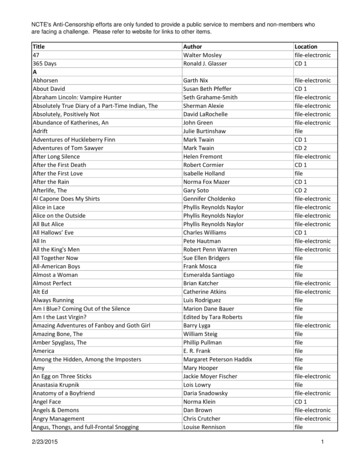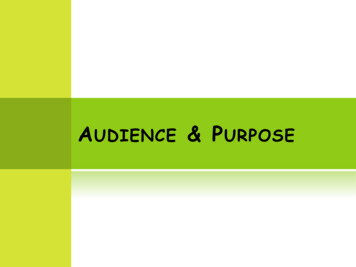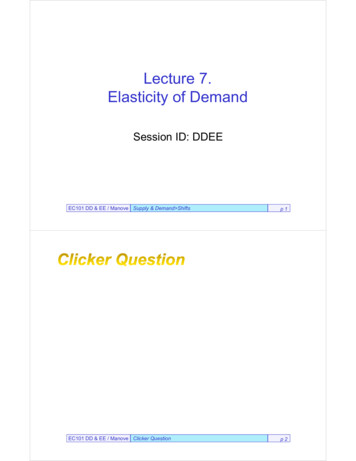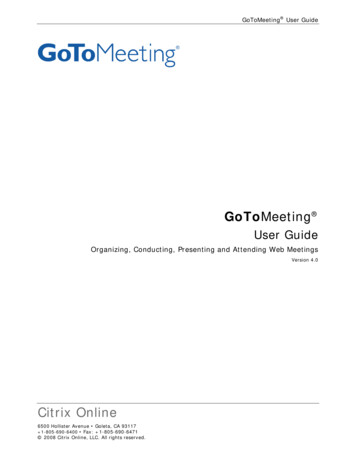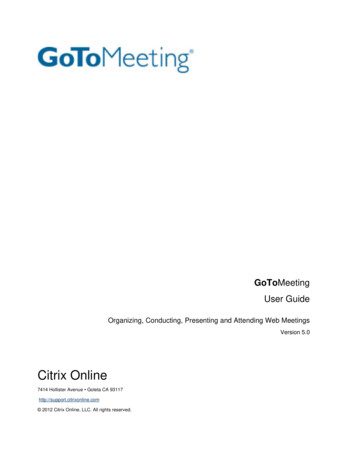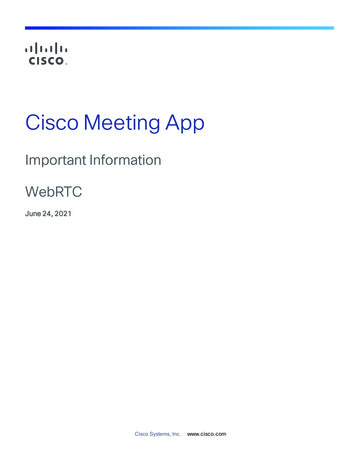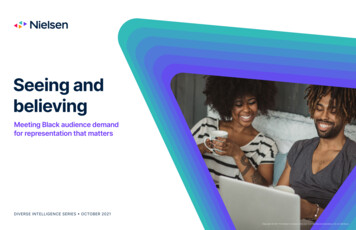
Transcription
Seeing andbelievingMeeting Black audience demandfor representation that mattersDIVERSE INTELLIGENCE SERIES OCTOBER 2021Copyright 2021 The Nielsen Company (US), LLC. Confidential and proprietary. Do not distribute.
ForewordFrom the foundation of our economy to today’s pop culture lexicon, the U.S. Black population has a complex and powerfullegacy that continues to shape our nation and cultures around the world. And yet when it comes to representation in media,the complexity that creates the richness of our experience is often lost, and when present, undervalued. Representation ofthe collective Black community remains critical. But in the era of personalization, so is the nuance. As we explore a few of thetrends and identities among Black audiences today, it’s an opportunity for content providers and brands to uncover ways tofurther enrich their representation.For many African Americans, content is our common language. Black audiences spend more time with media than any othergroup, with content engagement that consistently drives breakout hits and trending topics alike. Like all viewers, how Blackaudiences discover and discuss content is changing. Traditional media habits are blending with new paths to engagingcontent, building trust with brands, and finding opportunities to put Black culture front and center. Curating content for aunique Black experience is easier than ever but when available options fall short, creators are stepping up to tell the storiesthat are missing.As the media industry looks to be more inclusive of Black storytellers and grow their bottom lines or brand awareness withBlack audiences, understanding who we are, where we’re connected and how we’re changing is as important as ever. All of thiswork translates to an important acknowledgment of the value the Black community delivers “for the culture” and beyond.Representation of thecollective Black communityremains critical. But in the eraof personalization, so is thenuance.Charlene Polite CorleyVP, Diverse Insights & PartnershipsNielsenCopyright 2021 The Nielsen Company (US), LLC. Confidential and proprietary. Do not distribute.2
ContentsSeen and heard4More than quantity, quality5Transmitting live and on demand6Social media consumers and creators7Getting it right: creative control, content and culture8Exploring Black identities and the personalized media experience9Dive deeper: diverse identity profilesThe main streamer10The “phenomenal woman”11The HBCU fan12Methodology & contributors13Copyright 2021 The Nielsen Company (US), LLC. Confidential and proprietary. Do not distribute.3
Black buying power 1.57TRILLIONin 2020Black viewing power1.06TRILLIONTotal television & streaming minutes viewed in 2Q21Sources: Selig Center for Economic Growth, Terry College of Business, TheUniversity of Georgia, June 2021; Nielsen Media Impact, Time Spent with Total TVand Streaming, Q2 20212/3Two out of three Black viewersare more likely to:Watch representative contentBuy from brands that advertisein representative contentSeen and heardBlack America is taking control of both the economic and media influence they wield and using it to invest in Black experiences,Black communities and Black content.So the urgency to get representation right is real—it’s a primary factor for the massive viewing levels Black audiences deliver andthe shift in Black viewing power to platforms most representative of their community and identity group.But getting representation right is increasingly nuanced: 9% of America’s rural population is Black; 16% of Black people in the U.S.report speaking a language other than English at home; people identifying as “Black in combination with another race” increased89% in the last decade; and Afro-Latinos are 8% of today’s U.S. Black population (U.S. Census, 2020). The challenge to contentcreators now? Capturing this complexity within the population with authenticity and not erasure.When it comes to feeling seen on screen, Black audiences are embracing new technology at higher rates to increase their contentchoices, and have similar expectations when they encounter advertising. Personalizing ads for a consumer segment withoutaccounting for the diverse dimensions of that consumer can make promotions fall flat quickly. Combined, these trends arechanging how and where Black audiences show up and how brands connect with them.Access to content that reflects diverseBlack experiences requires multiple platformsMost representative platform by share of screen7.3%13.8%Black MenBlack LGBTQ Afro LatinasAfro LatinosSource: Nielsen Attitudes on Representation on TV Survey, May 20217.8%Black TCABLEPOPULATION ESTIMATESource: Gracenote Inclusion Analytics, Q1 2021Copyright 2021 The Nielsen Company (US), LLC. Confidential and proprietary. Do not distribute.4
SEEN AND HEARDMore than quantity, qualityIf presence in content was enough to meet the demand, Blackaudiences would be satisfied with today’s options. But justbeing present isn’t enough—setting the bar for representationas the presence of Black people on screen, equal to theirpresence in the population, may not be the right goal. Butrepresentation is so much more than a numbers game. Blackaudiences are paying attention to the stories that are beingtold about their community, and where they are showing up indifferent genres.Black representation in TV program genres(e.g. drama, comedy, news)26%51%Nearly a quarter of the reported genres in Gracenote InclusionAnalytics reported zero representation of Black talent inrecurring lead roles. Looking closer, there are still gaps in genreslike home improvement, history and educational content andBlack audiences are driving the demand to change that.23%ABOVE PARITY 14%BELOW PARITY 0BELOW PARITY 0Source: Gracenote Inclusion Analytics, Q1 2021How do you feel about the content on TV that features people from your identity group?10058%of Black audiences say there’s still notenough representation of their identitygroup on screen806039%60%87% of respondents were interested in seeing morecontent featuring people from outside their identitygroup, and 35% of viewers felt the portrayal of peopleoutside their own identity group was accurate*. Blackaudiences are leading the charge for more nuancedstorytelling, but they won’t be the only audiences tobenefit from it.4058%200Source: Nielsen Attitudes on Representation on TV Survey, May 20213%8%TOO MUCH32%TotalBlackABOUT THE RIGHT AMOUNTAfter years of being excluded from narratives AfricanAmericans today are especially attuned to when—andhow—they are represented on screen. On the leadingedge of popular culture, the trends Black talent set onscreen brings other audiences. Audiences are looking totelevision to see themselves as well as an opportunity toexperience other cultures and follow great stories.NOT ENOUGH*Source: Nielsen Attitudes on Representation on TV StudyCopyright 2021 The Nielsen Company (US), LLC. Confidential and proprietary. Do not distribute.5
SEEN AND HEARDTransmitting live and on demandThe preference to connect with meaningful content extends to audio with traditional radioreaching 92% of the U.S. Black population each week, and this same group of listenersaveraging over an hour and a half a week streaming audio.Traditional radio continues to prove the power of its reach providing the gossip, pandemicguidance and breaking news that’s kept Black listeners connected this year, for over21 million minutes a week. The trust and draw of radio were on full display as Americanswaited months to see—and hear—if justice would prevail in the case of George Floyd’s murder.92%Top of the Charts, Top of the PlaylistWhen iconic hip-hop trio De La Soul and soulfulsinger-songwriter Anita Baker gained control of theirmasters this summer, their announcements confirmedthat owning and monetizing their full catalog throughstreaming platforms was the next goal on their list. Thereturn of Aaliyah, a fellow 90s artist, to digital playlistsshows why.Years of anticipation for Aaliyah’s streamingdebut of “One in a Million” bumped the singer’sGracenote Music Popularity Score to itshighest in two years, jumping 12% since thestart of 2021.The renewed interest in the artist in the weeks followingher August 2021 streaming release also drove the25 year-old album into the Top 10 on the Billboard200 Chart.On the day of the Chauvin trial verdict, Black radio listenership spiked tothe highest level in three months. In a single day, radio reached more thanone-third of the Black population, an audience impact that usually takes thebetter part of a week to achieve.of the U.S. Blackpopulation tune intoradio each weekSource: Nielsen RADAR 148 Mar 2021(Contiguous US) Nielsen NationalRegional Database Fall 2020 (Alaska& Hawaii), M-Su 12M-12MSource: Nielsen RADAR 150, Black Listeners 12 , September 2021; Nielsen Audio Baltimore, Memphis & Minneapolis PPM data,Black Listeners P6 Podcast popularity growing across Black listenersJust as essential as Black hitmakers, is the community commentary that elevates them, a trend that points to why podcasts aresurging in Black listenership and industry investment.21%34%13%32%34%41%Black listeners aren’t juststreaming audio more thanother audiences, they’re listening closelywhen brands reach out—averaging a73% brand recall for podcast ads.11%14%AUG 2018DEC 2019BLACK 18-24MAY 2020BLACK 25-39NOV 2020BLACK 40-54MAY 2021BLACK 55 Source: Nielsen Podcasting Today, September 2021Copyright 2021 The Nielsen Company (US), LLC. Confidential and proprietary. Do not distribute.6
SEEN AND HEARDSocial media consumersand creatorsNot just for Gen Z65%When traditional content options don’t deliver, social media doesn’t just act as a key platformto celebrate or call out shortcomings. Social media’s omnipresence within Black people’sdaily media routine continues as a source for nuanced content. Black stories and brandendorsements have spread to a new class of creators powered by feeds, timelines and the#ForYouPage. As Black people become and seek out influencers, the sources trusted withnews, trends and entertainment exist at both the forefront and the fringes of digital media.In markets across the U.S. and around the world where Black representation in media can belimited, digital influencers are an even more important touchpoint.Leading social media usage on 4 out 5 social media appsBlack media users average daily time spent in minutes51Women 25-44 make up 65% of influencerand author Luvvie Ajayi Jones’ followingSource: Nielsen InfluenceScope, Instagram Profiles2xBlack people ages 35-44 spend almost twice as muchtime on TikTok daily than others in that age groupSource: Nielsen Media Impact, May 202138%Heavy social media engagement among Black Baby Boomersup 38% since 2020Source: Nielsen Scarborough R1 2021TikTok424830SnapchatTwitter241929And not just in the U.S.28InstagramFacebook2034BLACKSource: Nielsen Media Impact, May 2021GENERAL POPULATION87%of Black people in Brazil reported social media apps as the ones used most oftenSource: Nielsen Digital Consumer Survey - Brazil, 202110xProlific impersonator Grace Amaku, or @grace africa to 1M TikTok followers, has aglobal reach from Houston, Texas to Lagos, Nigeria, and an average engagement ratethat’s 10 times higher than other influencers with a similar-sized Instagram following.Source: Nielsen InfluenceScope, Instagram Profiles - Follower growth based on the last six months, September 2021Copyright 2021 The Nielsen Company (US), LLC. Confidential and proprietary. Do not distribute.7
Getting it right: creative control, content and cultureAs Black talent continue to make breakthroughs into a predominantly white media ecosystem,Black audiences continue to be vocal about cultural appropriation and injustice. Audienceinfluence and advocacy are intertwined as Black creators and viewers across platforms unifyto uproot exploitation within the media ecosystem and create a sense of urgency for socialchange.Black-influencedWhen it comes to scripted content, more Black voices in the writers’ room are making mustsee TV. Black talent at the table is critical to telling authentic Black stories, and Black writersshould also be empowered to tell stories “outside the box.”Triller’s reach with Black app users was five times theaverage reach for adults overall.Black-ownedWho decides and who profits from how stories get told is impacted by ownership. Recentexamples show just how much audiences are paying attention to who is in the boardroom.Black News Channel’s historic launch in 2020 made it the only cable network providing24-hour news programming that is owned and operated “by people of color for people of color.”Networks like BET have catered to Black audiences since its founding but are taking the call forinclusion a step further not only to develop and air representative content, but also to createopportunities for ownership. The new venture BET Studios will provide equity ownership to theBlack creators responsible for the content. (BET, September 2021)When founders Swizz Beats and Timbaland sold Verzuz to Triller in March 2021, they shareda stake of their equity with over 40 performers that helped make the virtual concert seriesa success. By June, Triller’s reach with Black app users was five times the average reach foradults overall.**Source: Nielsen Media ImpactBehind the scenes & on screen: the impact ofrepresentation on TV dramas27%of credited writers were Black on the most representative broadcast and cabledramas for Black talent in the first-quarter of 2021.70%Representation isn’t just for endemic networks: seven out of the 10 top dramas byrepresentation of Black talent aired on general audience networks.Source: Gracenote Inclusion Analytics, Q1 2021 Top 10 Dramas by Black Share of Cast; Gracenote Studio System, Writers by Known RaceCopyright 2021 The Nielsen Company (US), LLC. Confidential and proprietary. Do not distribute.8
Black identities and the personalizedmedia experienceThe advancements of curated content lists, on-demandscheduling and customized commercials mean moreopportunities to enhance audience experiences thanksto today’s technology. But outlets and advertisers thatdo not take into account how today’s demographicsinfluence identity may still end up missing the mark.The diversity of the diasporaIn the era of personalization and inclusion in media, Black audiences around the world are looking to see both theircollective and distinct experiences represented. From slang to skin tones, diving deeper within the monolith revealsdiverse identities among Black people informed by experience and by region.Source: Nielsen National TV Universe Estimates, June 2018 vs. June 2021U.S. - Black America deliversover 1 trillion viewing minutesin a single quarter but arealso twice as likely to feelportrayals of their identitygroup on TV are completelyinaccurateSource: Nielsen Media Impact, Time Spentwith Total TV and Streaming, Q2 2021;Nielsen Attitudes on Representation on TVStudy, May 2021GekleurdCreoleAfro-IndigenousPretoBlack CaribbeanHaitianEast AfricanPardoBlack AmharaHausaNigeria - The most populouscountry in Africa outsourcesglobal trends like Afrobeatsand “Nollywood” films and isconsidered home for 18% offoreign-born Black people inthe U.S.Source: U.S. Census, 2019Source: U.S. Census, 2019Is your brand message, content or creative as diverseas the Black population you hope to reach? In this newday, brands and content providers must begin to explorethe experiences and identities of Black people within theU.S. and around the world.West AfricanAfrican AmericanOromo Igbo FrenchSouth AfricanJamaica - A culturewith global influence,including places likethe U.K. and 20% ofthe foreign-born Blackpopulation in the U.S.Afro LatinoJamaicanYorubaBlack viewers are drawn to thepersonalized experience connectedTV can offer with a rate of adoptionup 82% since 2018—outpacing theoverall growth at 56%Black BritishBrazil - 108 million Brazilians identify as“Black” and “Brown”; only 39% of BlackBrazilians feel represented in ads.Source: CIA World Factbook, Nielsen Brazil DigitalConsumer Survey, 2021South Africa - Home to 15.9million television householdswhere African Black viewers makeup 79% of the viewing populationand average a 14.6 ratingSource: Nielsen South Africa, Weekly Total Viewingby Race 2021Copyright 2021 The Nielsen Company (US), LLC. Confidential and proprietary. Do not distribute.9
DIVE DEEPER: DIVERSE IDENTITY PROFILESThe main streamerHow he feelsBlack men have a high on-screen presence in TV content with a 15.5% share of screen, but 44% of Black men feel that thecontent that portrayed their identity group on screen was inaccurate. And while the number of advertisers spending intraditional media focused on reaching African Americans is up 16% since last summer, Black men are increasingly engagedoutside of these platforms to find the forums that offer nuanced representation, connection and solace. This migrationleaves untapped potential for brands to engage with “The Main Streamer” on his turf and with messaging that reflects whatthe broad strokes of representation often miss.Source: Gracenote Inclusion Analytics, Q1 2021; Nielsen Attitudes on Representation on TV Survey, May 2021; Nielsen Ad Intel Q3 2020-Q2 2021Where to find himThe variety among podcast options has made this a media staple for Black men in particular.Twitch’s reach among Black men outpaces the platform’s reach with men overall. This level of engagement is a partof why creators, users and the platform itself are sounding the alarm to end “hate raids” and other forms of onlineharassment that disproportionately impact Black gamers.Podcasts deliver choice and authenticityfor Black menMore likely to listen topodcastsTime spent listening topodcasts in typical week6-7x per monthIndex 1718-10 hrs per wkIndex 135Source: Nielsen Scarborough Podcast Buying Power (USA ), May 2021Black men average double the amountof time on TwitchAverage daily timespentMonthly reachSource: Nielsen Media Impact, May 202177 minutesTotal men 34 minutes23%Total men 21%Who he followsKris Lamberson, better known as @Swagg to2.4 million YouTube channel subscribers and 1.9million on Twitch, has also seen his Instagramfollowing increase 40% in the last six months, withsignificant reach among men aged 18-34.@storymodebae, aka Briana Williams’ has seentriple-digit growth, 133%, to her “Bae Brigade” inrecent months, a following that is over 70% men.Source: Nielsen InfluenceScope, Instagram Profiles, September 2021Copyright 2021 The Nielsen Company (US), LLC. Confidential and proprietary. Do not distribute.10
DIVE DEEPER: DIVERSE IDENTITY PROFILESThe “phenomenal woman”What she’s looking forAs described in Maya Angelou’s poem, Black women’s experiences range from triumphs to struggles, wins andlosses, and they are seeking content that reflect that diversity.When Oprah Winfrey Network (OWN) acquired rights to re-air the acclaimed “Underground” series in late2020, fans were thrilled but left wanting more of the story than the show’s original two seasons. When anotheropportunity presented itself this year following the cancellation of “All Rise,” OWN didn’t just revise the show,they committed to producing a third season in 2022. Black women were 10% of the cast in the most recentseason, but they were 14% of the audience and tuning in with a sense of urgency. While the latest episodesaveraged a 9% overall uptick in DVR playback viewing in the weeks that followed an episode’s premiere, forBlack viewers of the show that increase was just 3%. The investment of the Oprah Winfrey Network to producetheir own lineup of diverse Black stories and breathe new life in others is an example that demonstrates theimportance of Black women in the audience feeling connected through inclusive content.Source: Gracenote Inclusion Analytics - Genres with 10 programs, Q1 2021; Nielsen NPOWER: All Rise April-May 2021, P2 (000), Live 7 vs Live 35Where she’s connecting2xBlack women are twice as likely compared toviewers overall to seek out content where they’reseen on screen. But the need for community and connectiondoesn’t stop there.A community for self-careTabitha Brown’s unique personal brandof positivity, faith and creative vegan recipes hasamassed a following that is 88% women including10% of her 3.8 million followers outside the U.S. inmarkets like the U.K. and Canada.Where she’s goingBlack women are 2.5 times more likely to beplanning a spa vacation in the next year comparedto women overall.CurlBOX creator Myleik Teele has been leading in thebusiness of beauty for 10 years, with an engagementrate more than double influencers with similar sizefollowings.Source: Nielsen InfluenceScope - Instagram Profiles, September 2021Source: Nielsen Scarborough USA 2020 Release 2Copyright 2021 The Nielsen Company (US), LLC. Confidential and proprietary. Do not distribute.11
DIVE DEEPER: DIVERSE IDENTITY PROFILESThe HBCU fanWhen brands show they understand the nuances of the Blackexperience, it is an opportunity to connect with diverse communitieson personal, culturally relevant levels like never before. Embracing the impact of historicallyBlack colleges and universities (HBCUs) is one example.HBCUs aren’t just about a college education. HBCUs continue to meet the demand for safespace by placing African American culture at the center of their collegiate experiences.But their impact goes far beyond their alumni base. Partnerships in the last year have alsoexpanded collaborations with professional sports to celebrate the influence of HBCUs duringaudience favorites like NBA All-Star Weekend, the U.S. Open and NFL Kickoff. Sports brandsand their advertisers who tap into the competitive spirit within the underserved HBCUcommunity are also tapping the most coveted consumer segments.Photo by Kevin ColesOrange Blossom Classic winswith high-income Black viewersReach among households earning 100K 8%Black households2%TrendsettersBlack womenFashion and beauty editor, Kahlana BarfieldBrown combined her passion for the HBCUexperience and fashion-forward design in Target’s“Black Beyond Measure” campaign. A powerfulcombination given the influencer’s unique deliveryof follower quality and topic relevance among herengaged Instagram community.The day Nikole Hannah-Jones and Ta-NehisiCoates announced they would be joining theHoward University faculty, Joy Reid’s interviewwith the pair drew a 13% increase in Blackviewers to MSNBC’s The Reidout compared tothe prior week—55% of them Black women.Source: Nielsen InfluenceScopeSource: Nielsen NPOWER P2 Average Audience Ratings, Live SameDay, 7/6/2021 vs. 6/29/2021All householdsSource: Nielsen NPOWER: ESPN2 NCAA Football, 9/5/2021, Live Same DayHousehold ReachCopyright 2021 The Nielsen Company (US), LLC. Confidential and proprietary. Do not distribute.12
Methodology & ContributorsGracenote Inclusion AnalyticsDesigned to accelerate diversity and equity in media,Gracenote Inclusion Analytics illuminates representationof on-screen talent compared with audience diversity. Thesolution empowers content owners, distributors and brandsto make better informed decisions around inclusive contentinvestments. www.nielsen.com/inclusionanalyticsGracenote Music Popularity ScoreGracenote Global Music Data Popularity Score is basedon U.S. artist popularity averaged using a proprietarymix of inputs from the most comprehensive collection ofstandardized artist and recording IDs, editorial data and sonicdescriptors.Gracenote Studio SystemGracenote Studio System offers the most comprehensive,accurate and up-to-date information available on Hollywood’smost important people and projects. Studio System is a webbased service and mobile app that enables subscribers totrack TV, film and digital content in development, researchbox office numbers, browse TV premiere dates and seewinners from every major award show and film festival.Nielsen Attitudes on Representation on TV SurveySurvey of over 2,000 smartphone respondents via Nielsen’sComputer and Mobile Panel, weighted for age, gender, race,ethnicity income and Android and iOS users conductedMay 2021.Nielsen AudioAudience estimates for 48 large U.S. markets are based ona panel of respondents who carry a portable device calledthe Portable People Meter (PPM) which passively detectsexposure to content containing inaudible codes embeddedwithin. Audience estimates for the balance of markets in theU.S. are based on surveys of people who record their listeningin a written diary for a week. Nielsen RADAR reports nationaland network radio audience figures using both PPM andDiary measurement to create a national footprint based on asample of 400,000 respondents.Nielsen InfluenceScopeInfluenceScope is the Nielsen Media one-stop solution tosupport marketers throughout the entire Influencer MarketingLifecycle. From selecting creators for social media campaigns,to measuring the return and effectiveness of the influencermarketing activities, InfluenceScope always provides themost granular data-driven answers. Through in-depthresearch, Nielsen has determined 4 key dimensions to providethe most reliable and consistent criteria for a comprehensiveassessment of every personality (reach, relevance, resonanceand return). InfluenceScope is based on 20 social mediametrics, digital audience data and a database including 100million influencers.Nielsen Media ImpactFor national planning, Nielsen Media Impact uses respondentlevel data from Nielsen’s Total Media Fusion, which includesTV, VOD, SVOD, digital, digital-place based, print, radio andcinema. For local planning, Local Nielsen Media Impact usesrespondent-level data from Nielsen’s Local Media Fusion,which includes TV and radio.Nielsen National TV MeasurementTelevision data is derived from Nielsen’s National TV Panelthat is based on a sample of over 40,000 homes that areselected based on area probability sampling. Data used in thisreport is inclusive of multicultural audiences.ContributorsCharlene Polite CorleyChristine PaolucciPatricia RatulangiVeronica HernandezStacie deArmasSalvatore De AngelisJasmin FlackSabrina BalhesSandra Sims WilliamsTommaso BernardiJamie MoldafskyGuilherme OliveiraBill QuinnPhilippe Ferreira GrujeMike LakustaJanay BattleJon MillerDenise HendershotJane ShapiroSarah Aba LevittArica McKinnonJustin FranksErick SanteroTameisha BrownJuan DataKevin ColesNicolas LienPetro van StadenLisa BoudreauInnocent MunyaiNielsen ScarboroughNielsen Scarborough USA measures the unique shoppingpatterns, product usage, demographics, lifestyles andcross-media behaviors of the American consumer at a local,regional or national level, giving the ability to profile over2,000 measured categories and brands.Copyright 2021 The Nielsen Company (US), LLC. Confidential and proprietary. Do not distribute.13
About NielsenNielsen shapes the world’s media and content as a global leader in audience measurement,data and analytics. Through our understanding of people and their behaviors across allchannels and platforms, we empower our clients with independent and actionable intelligenceso they can connect and engage with their audiences—now and into the future.An S&P 500 company, Nielsen (NYSE: NLSN) operates around the world in more than 55countries. Learn more at www.nielsen.com or www.nielsen.com/investors and connect withus on social media.Audience Is Everything
100 32% 60% 8% 58% 39% 3% After years of being excluded from narratives African Americans today are especially attuned to when—and how—they are represented on screen. On the leading edge of popular culture, the trends Black talent set on screen brings other audiences. Audiences are
